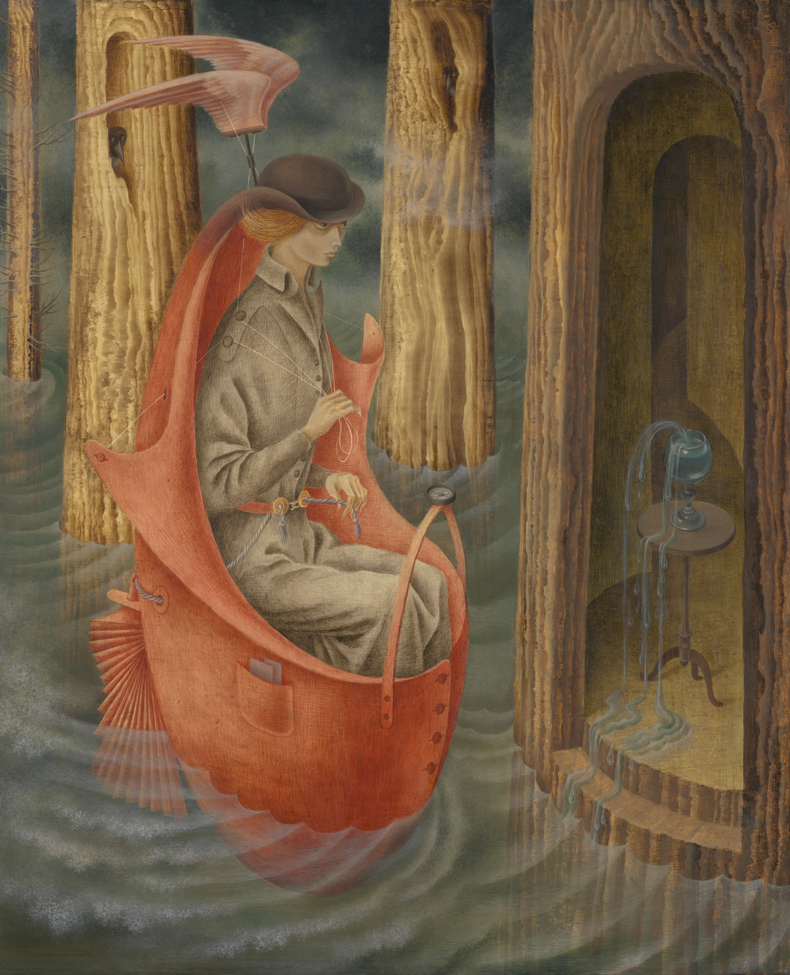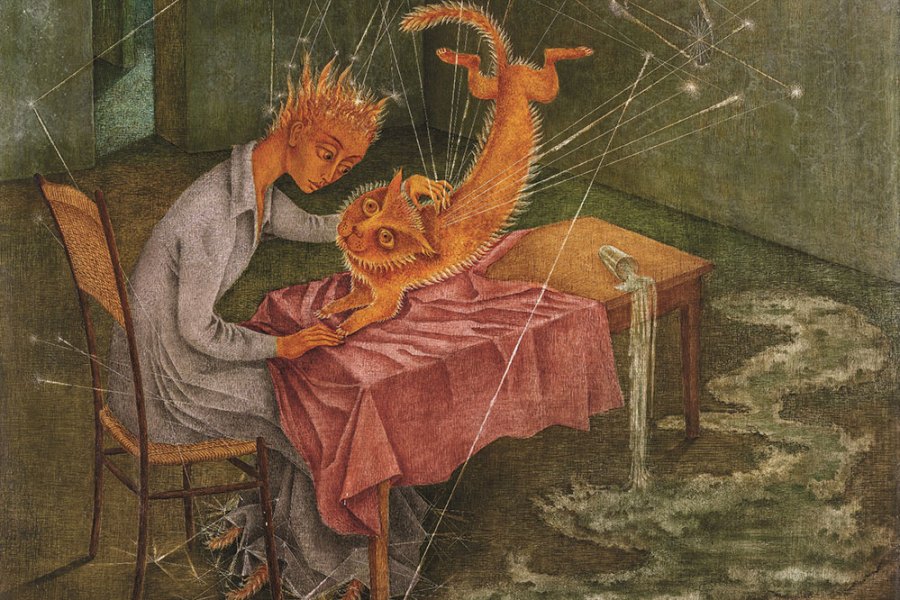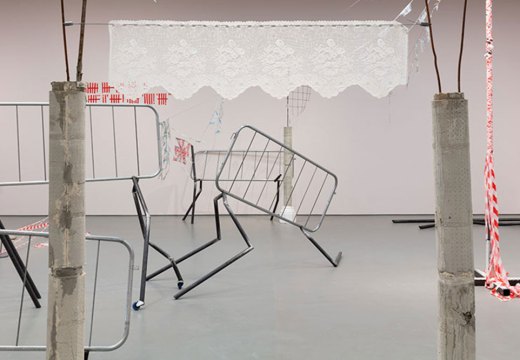From the October 2023 issue of Apollo. Preview and subscribe here.
I can’t remember the last time I found myself in an exhibition trying to imitate a figure in a painting. Yet one of the paintings by Remedios Varo (1908–63) in the tightly curated retrospective at the Art Institute of Chicago had me pulling imaginary drawstrings around my neck. I wanted to see what it might be like to steer one of the extraordinary vehicles that she renders so vividly in her work. Despite the Spanish-born painter’s close affiliation with Surrealism and her declaration that her work corresponded with an ‘intuitive, divinatory, and irrational order’, the engineering of the mechanisms she conjured is so considered, so intricate, that I can envision them being real.
‘Conjuring’ is the key word here. This show, which focuses on the work Varo made in Mexico City during the last eight years of her life, between 1955 and 1963, emphasises her genius for invention. She used various compositional strategies to reveal the passage of time and movement through space. In the fantastical (and fantastic) painting Creation of the Birds (1957), an avian creature with an owly head and feathered body draws birds that come to life when touched by starlight filtered through a prism. An anthropomorphic contraption, a sort of paint percolator, drips primary colours on to a palette. The drops, the wings and the ray of light all contribute to a sense of duration; it is easy to imagine this process of creation being animated, as one bird after another takes off from the paper. Art begets life.
Indeed, alchemy is a frequent motif in Varo’s oeuvre. Her restless intellect led her to explore various schools of thought that included magic, occultism and witchcraft, as well as archaeology and anthropology. One of Varo’s close pals was fellow Surrealist Leonora Carrington, who introduced her to the philosophy of George I. Gurdjieff, a spiritualistic guru who championed the idea of a fourth dimension and whose followers included the English painter Christopher Fremantle. Fremantle lived in Mexico – where Varo settled in 1941 – and taught art workshops, which she frequented, in which participants stared at an object for several hours to imprint its shape on their minds.
Through studying Gurdjieff and working with Fremantle, Varo came to believe in the concept of ‘objective art’, the idea that art derives from a higher cosmic order and thus has the power to induce psychological or physical change. Perhaps resulting from this belief, systems abound in Varo’s paintings. In these paintings, there is no chaos, no randomness. Everything moves via invisible networks that circulate around us and, since everything is connected, there is a cause for every event. In Simpatía (Sympathy) of 1955, an encounter with a cat results in a flurry of static electricity that sets off a chain reaction in which needle-like beams bounce and pinwheel off the walls; both the cat and its mistress share the familiar yet uncanny sensation of having their hair stand on end.
Music is not merely auditory filler, but rather an element that, like sun or wind or water, might be exploited. In Armonía (Harmony) from 1956, a composer manipulates an instrument resembling a musical staff and mysterious figures emerge from the walls. In Vuelo mágico (Magic Flight), also from 1956, the music from a hurdy-gurdy propels aloft a figure wearing a coat with kite-like flaps. Música Solar (Solar Work) of 1955 shows a figure covered by a grassy cloak pulling a violin bow across a sunbeam.

Exploración de las fuentes del río Orinoco (Exploration of the Sources of the Orinoco River) (1959), Remedios Varo. Private collection
Perhaps I’m responding to the current socio-political climate, where the wellness industry overlaps with anti-vaxxer conspiracy theories, but I find myself less interested in the ‘fiction’ part of Varo’s work and more intrigued by the ‘science’. Despite her disavowal of ‘rational’ thinking, many of the machines she depicted seem plausible. The drawstrings I was trying to manipulate, for example, are what controls the splendid egg-shaped watercraft drifting in a flooded forest in Exploración de las fuentes del río Orinoco (Exploration of the Sources of the Orinoco River) of 1959. The painting was, as the title implies, inspired by the recent discovery of the Orinoco River’s source, a mystery that had puzzled explorers for centuries. Varo was fascinated by the river while she lived in Venezuela for a year in the late 1940s and accompanied a scientific expedition looking for gold along the Orinoco. The potential of water to create energy was also familiar to her; Varo’s father, a hydraulic engineer who designed canals in Morocco, taught her how to draw. To emphasise Varo’s world-building abilities, the exhibition includes a selection of science fiction novels from her library. Yet I would have liked to have learned more about Varo’s technical interests. Did she, like Leonardo, in whose ideas she was interested, ever produce designs with the object of seeing them realised?
Varo lived through two world wars and was no stranger to suffering (she spent time in the winter of 1940 in prison in France), yet she was also alive during an extraordinary period of innovation and exploration, both literal and figurative: geographic exploration of the land and the discovery of unmapped sites paralleled psychological exploration of the mind and the discovery of the unconscious. (At one point her livelihood came from making drawings for pharmaceutical companies advertising drugs to alleviate anxiety.) In Mujer saliendo del psicoanalista (Podría ser Juliana) (Woman Leaving the Psychoanalyst [Could Be Juliana]) of 1960, an elegant woman wearing a bright green shawl-like coat that conceals her mouth casually deposits a ghostly bearded head into a well. This may be Varo’s most overtly feminist work, at least in this exhibition; as the woman dispatches this patriarchal figure, her white hair parts in the middle and curves from the top of her head like horns. What will this woman do, now that she has liberated herself? If the works in this show are any guide, there is no limit to what she might achieve.
‘Remedios Varo: Science Fictions’ is at the Art Institute of Chicago until 27 November.
From the October 2023 issue of Apollo. Preview and subscribe here.
Unlimited access from just $16 every 3 months
Subscribe to get unlimited and exclusive access to the top art stories, interviews and exhibition reviews.














![Masterpiece [Re]discovery 2022. Photo: Ben Fisher Photography, courtesy of Masterpiece London](http://www.apollo-magazine.com/wp-content/uploads/2022/07/MPL2022_4263.jpg)
It’s time for the government of London to return to its rightful home